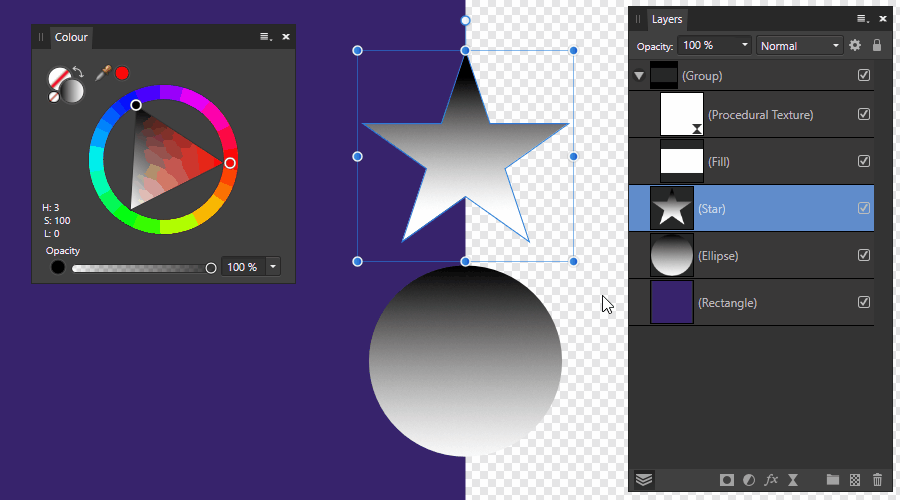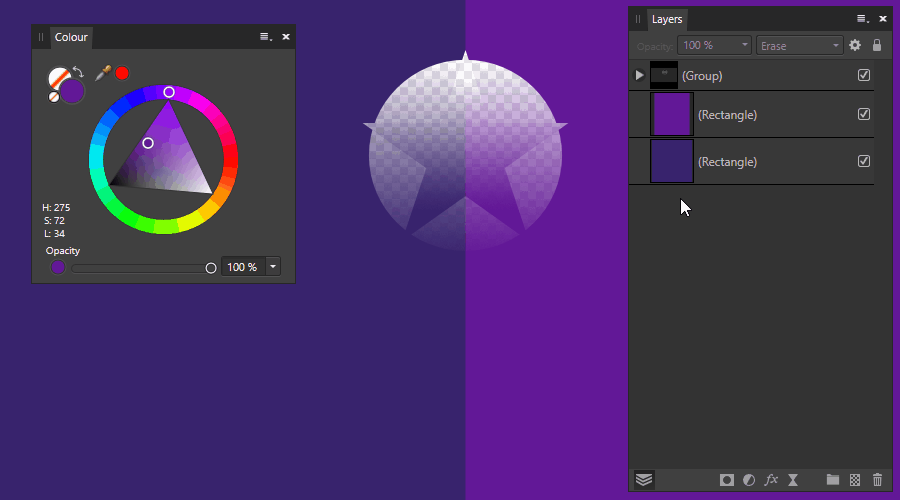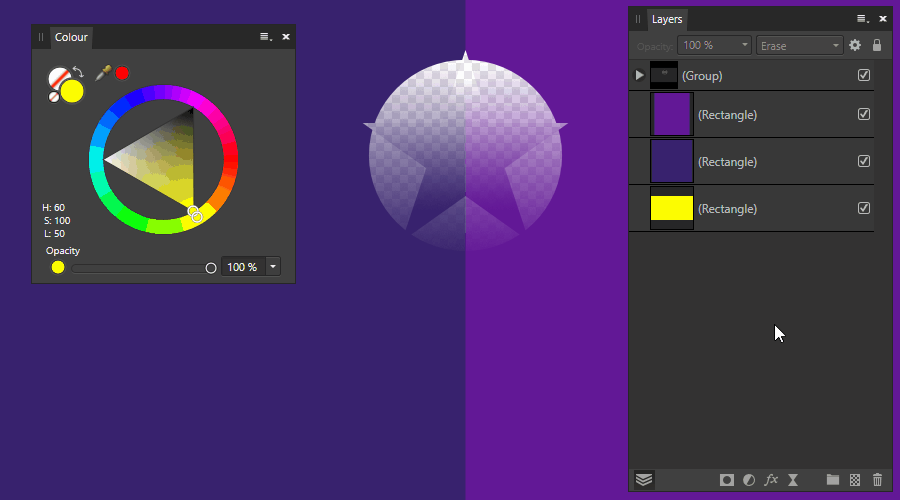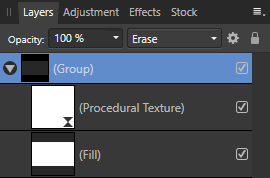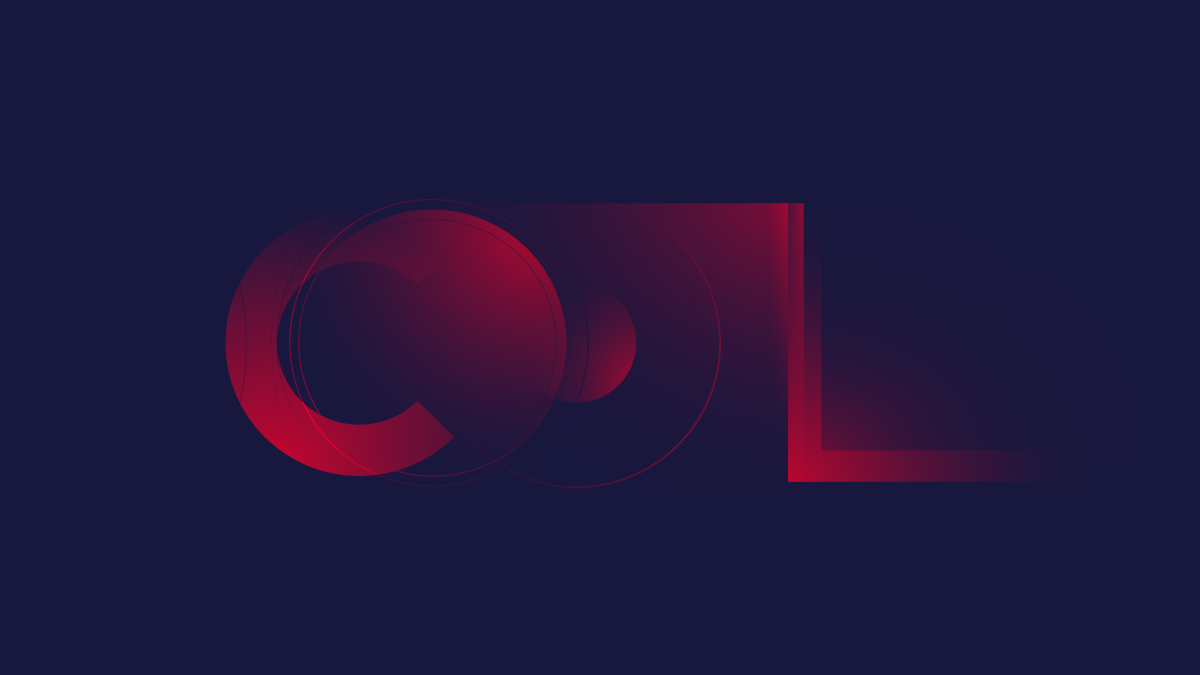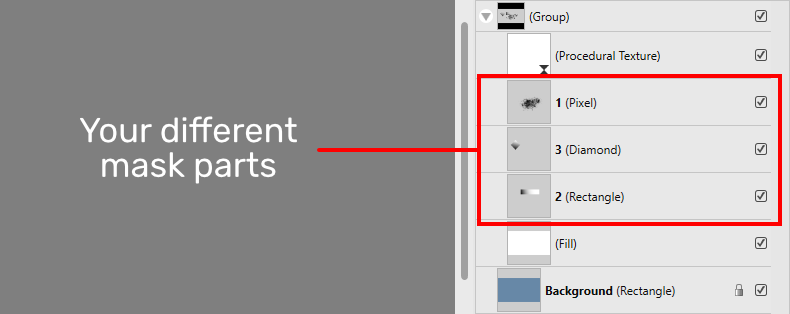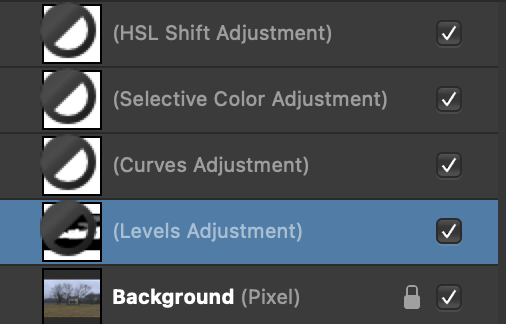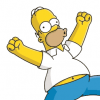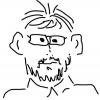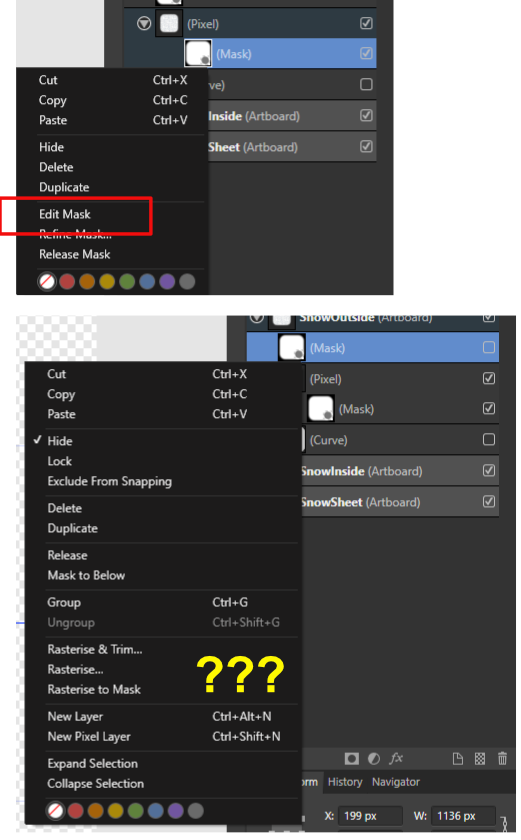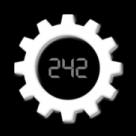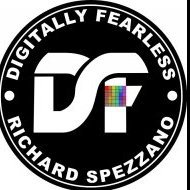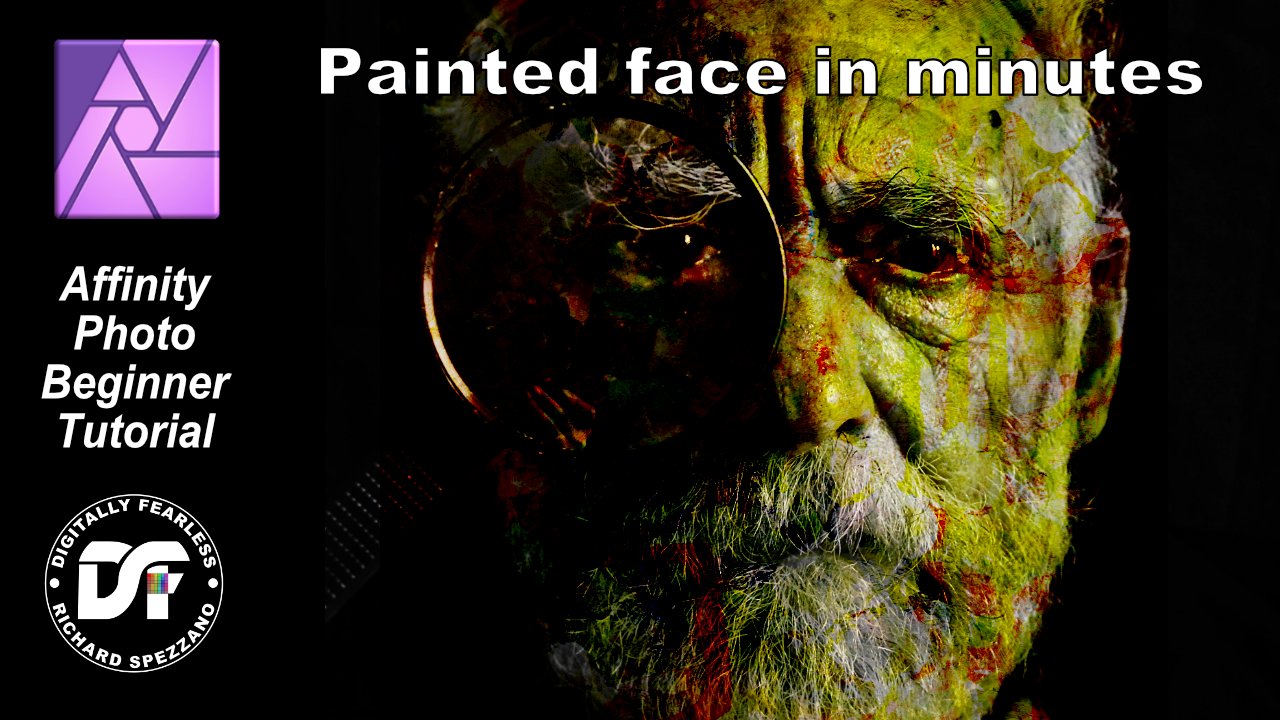Search the Community
Showing results for tags 'Mask'.
-
Hello, Where am I going wrong, please? I want to cut out the policeman’s cap. 1 I crop the image so I can see just the cap. 2 I cut out using the pen tool 3 I click mask 4 I Cmd-C and Cmd-V into a new Affinity Photo file. See RBhBwyuhb6K3E2Y1AnDVaIsa9z4hkk The issue I have is that this takes over the cropped elements of the file. Help appreciated! Will
-
This is a completely non-destructive mask, which is a group of many layers. You can use many raster and vector layers/objects in one mask. And of course, you can edit them! Nondestructive_Mask.afphoto Nondestructive_Mask_Test.afphoto Nondestructive_Mask.afassets How to use Place your mask parts between the Procedural Texture and the Fill Layer. If necessary, change the background transparency, changing the Fill Layer color. To apply this mask-group only to a specific layer, nest it. To apply a mask-group to multiple layers, select mask-group and desired layers below, and group them. Then change blending mode for this new group, from Passthrough to Normal. How it works This is a group with the "Erase" blending mode. This group has two main layers, the Procedural Texture and the Fill Layer. The Procedural Texture turns rgb and grey pixels into alpha. Formula: 1-rgbtoi(R,G,B)-a=Alpha Many thanks to @NotMyFault Fill layer is required to control the background transparency. In conclusion This non-destructive composite mask allows you to fine-tune individual parts of the mask, achieving the desired result. Affinity interactivity allows you to see the result of your operations in real time, unlike some other programs. Opportunities Nondestructive editing and moving Multiple individual mask parts Vector and raster Color and greyscale Applying adjustments Created using a mask consisting of many parts
-
I am running 1.9.1.979 on Windows 10. I am unable to paint black on any mask, adjustments or pixels; painting white is fine on a mask or an inverted mask. Painting black has no effect. mask_problem.afphoto
- 7 replies
-
- affinity photo
- mask
-
(and 1 more)
Tagged with:
-
When the monochromatic iconography selection is ON the adjustment layer mask have a black/white circle overlay on them rather than being totally white or black (inverted). This circular icon blocks the users ability to see the strokes made by painting with the black or white (when inverted) brush. When the monochromatic iconography is OFF it shows the mask fully and any adjustments made by painting with the black or white (when inverted) brush is clearly shown. Attached is a screen shot of the Layers panel with the monochromatic iconography in the ON position. The highlighted Levels Adjustment layer shows an inverted mask with the center section painted in white. Everything is displayed perfectly when the monochromatic iconography is OFF. I'm using a MacPro laptop, Big Sur OS, Affinity Photo version 1.9.1
- 1 reply
-
- monochromatic iconography
- layers
-
(and 2 more)
Tagged with:
-
I tried the mask layer linking that @carl123 demonstrated. The linking of masks worked fine for me. I then tried editing the linked-from-mask, and the linked-to-mask, both masks reflected edits of either. But while the actual layers updated, the thumbnails were updated going one way but not the other. See circle on unsharp-mask mask but not on levels mask. (macOS 11.2)
-
I have a B&W pixel layer that I have converted to a mask layer and put inside a live adjustment layer. I decided that I want to boost the contrast of the mask after I had put it into the live adjustment layer. How do I do that? Preferably non-destructively such as adding the Levels adjustment to the mask for more control. If not possible I'm still happy with a destructive method too. In Photoshop I just ALT+CLICK on the mask to make it active and then CTRL+L to adjust the Levels of the mask.
-
So I've been trying to work with masks and the "Hold ALT" colour picker... it's BAD. When I hold down ALT with the intention to pick a value FROM THE MASK to apply it somewhere else in it, the tool simply decides to pick the GLOBAL value of the document instead, which makes working with masks a complete pain as I want to pick the value from the actual mask to control the ALPHA value for that mask alone. Switching to the Isolated view of the mask makes NO difference at all, it still picks the value of the Parent Layer. The only exception to this problem is if you select the Colour Picker tool MANUALLY, which is slow enough to break my flow. Why doesn't the "HOLD ALT" method use this behaviour as when you select the Colour Picker Tool manually? If holding ALT supposed to be just a quick shortcut to switch between the brush and the picker, why doesn't it work the same as the properties you assign to it in the first place? Is there a workaround to this?
-
Using the Dodge and burn on a mask layer is handy when using to affect only shadows, midtones or highlights. Eg. Dodging a lighter sky through a dark tree. Tx
-
Change size of circle with zoom
dad2five posted a topic in Feedback for Affinity Photo V1 on Desktop
I would like it if when I'm zooming with the circle selecting a mask, that the circle itself would stay the same size relative to the screen but change relative to the zoom. I would also like it if the was a button to switch between add and subtract but you just push and then mouse click and drag to subtract. Add would just be mouse click and drag. -
Hello, having some difficulty with masks in affinity designer. Is it possible to convert a mask to a pixel layer? Rasterise does nothing. How can you edit a mask when it's above another layer and not attached to one? Is it possible to invert a mask? using invert from the menu does nothing. Is it possible to view channels in affinity designer? I've searched for these questions but only find answers for affinity photo so any help would be much appreciated.
-
This is weird: One of the most common tasks for me in Affinity Designer (IPad pro) is to use the Vector Crop tool to remove unwanted parts of an image, and at first this only crops to the shape of a square or rectangle so you wouldn’t use it to crop a complex shape.... BUT it creates a mask in your layers tab so you should be able to then manipulate that mask’s nodes/curves just like any other vector right? kind of. Yes. If you know the secret. At first you won’t be able to edit the points or lines in the Vector Crop mask. But I discovered that if you select the Corner Tool, and then round any corner of the mask (And then un-round it again because you likely weren’t wanting to round the corner), suddenly the mask’s points become editable like any other vector shape. I do this dozens of times per session. Why?! Why should I be conducting this random and oblique method just to edit my vector crop mask? Haha. Please fix this! -Noydis
- 4 replies
-
- vector crop tool
- mask
-
(and 1 more)
Tagged with:
-
https://www.bodobe.de/fee-2/
-
Hi, when using a mask layer applied to a member layer of a live stack group, the mask behaves strange: observed: If the mask value is 255, the pixel is inlcuded and shown. If the mask value is bewteen 0 to 254, the pixel is not shown. Expected: Values between 0 and 254 should lead to an pixel with accoring alpha. You can try at your own by adjusting the slider of the levels adjustment. You can see that it only affects which pixels are shown (when reaching alpha 255). I might be wrong with my expectation live_stack_and_mask.afphoto
-
Hi, y'all... I just purchased a vector image for my project. It looks like this (see pic bellow) if I open it on Affinity Designer. How can I edit the pic? I just need to make it smaller or bigger, and modify it for my project. I am very thankful for any hints.
- 3 replies
-
- affinity designer
- mask
-
(and 1 more)
Tagged with:
-
Painted Face in Minutes! Affinity Photo beginner tutorial on how to give a face a painted look in just minutes. The tutorial uses black and white photos and a black background to manipulate the photo. https://youtu.be/lhoqEDRjELQ
-
- photo manipulation
- affinity photo
- (and 8 more)
-
This is driving me nuts and I'm sure there's a simple answer. I use clipping masks a lot when laying out content. In Illustrator, once I've placed the mask, I can easily resize/reposition the masked image without affecting the size or position of the mask itself. In Affinity Publisher, however, once I mask an image, I can reposition/resize the mask to my heart's content, but I can not for the life of me find a way to reposition or resize the image within the mask without releasing the mask altogether. Is this possible? If so, how?
- 4 replies
-
- clipping mask
- mask
-
(and 2 more)
Tagged with:
-
Hi. How can I "connect" (and "disconnect") a mask to his layer, to modify the layer (rotate, enlarge, etc.) into its mask without rotating, enlarging, etc. the mask ??? Is there a symbol or something that shows the layer "connected" or "disconnected" to its mask ? In few words: if "connected", each modification affects either the layer and the mask...if "not connected" it will affect the layer and not the mask. I hope that is clear... I'm sure it's easy and on my watch, but it's driving me crazy Thank you!
-
I feel like I'm being a bit stupid, but I just can't figure it out. I'm using a curve adjustment layer, with a grey scale image as a mask. As you can expect, a mask is just a normal pixel image, meaning I can manipulate it how I want, use a brush, whatever. What I'm trying to do is to increase contrast of the mask image, by using an adjustment like curves or levels. But I just can't figure out how to use adjustments on a mask! It always creates a new, separate adjustment layer, not manipulating the existing mask. What am I missing?
-
Hello, why does masked adjustment layer yields different result depending on whether mask is applied directly (correct result) or on the group that adjustment is nested inside. Could it be because I work in 32 bit mode?
- 9 replies
-
- mask
- adjustment
-
(and 2 more)
Tagged with:
-
Hi... I have a thing that make me crazy... the cropping tool does not works as photoshop. when you crop a picture, the image still exists beyond limits, same happens when you mask something... so i export a part of a picture but the image resulting is not only the selected item that i want to export. A masked object is exported (blank) beyond its limits creating a exported image with incorrect dimensions. I try to use the slice tool but does not work for me... is there any way to export what we see, not the whole masked objects... is so unproductive to export and load the image to cut it Thanks



